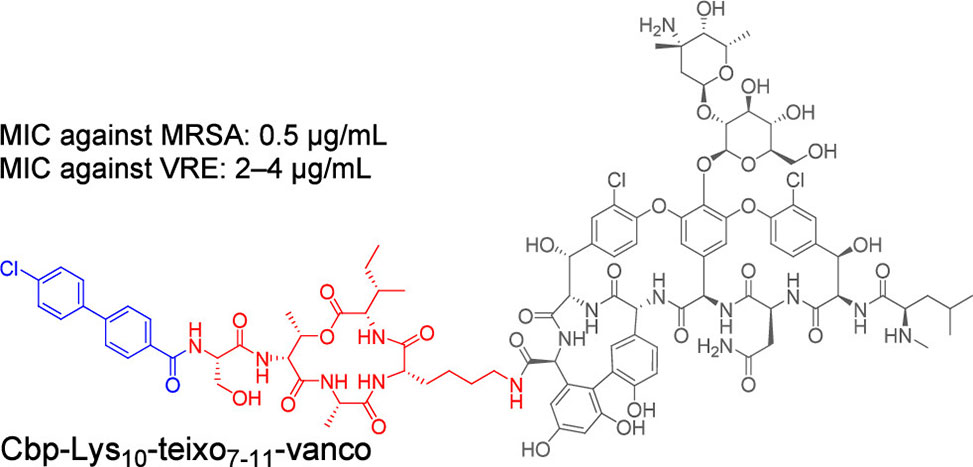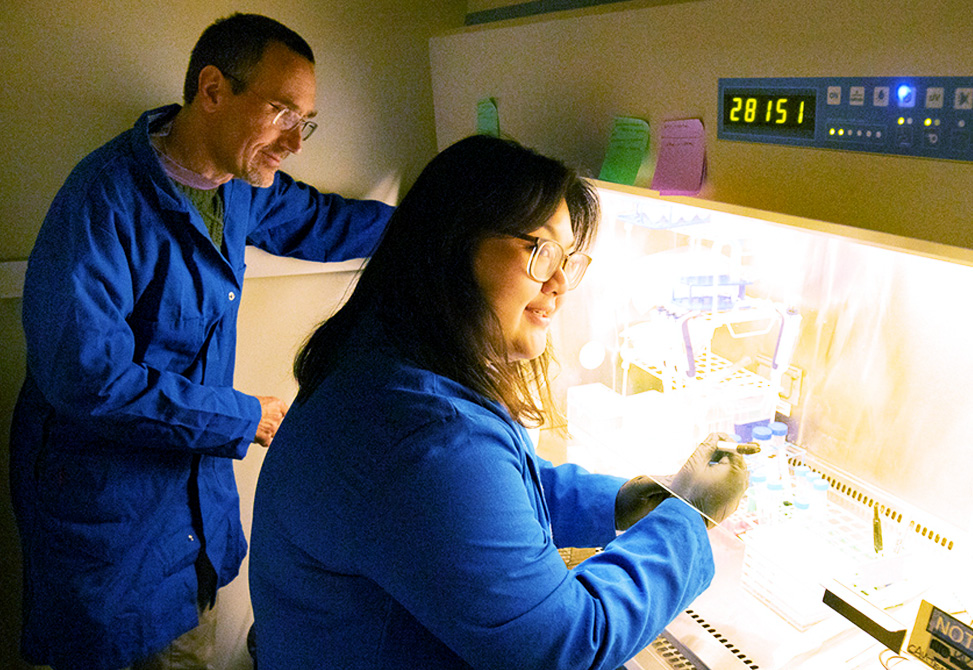Vancomycin–Teixobactin
Reflecting work in the Nowick Lab
Vancomycin, a cornerstone antibiotic for Gram-positive infections, faces diminishing efficacy due to the emergence of vancomycin-resistant Enterococci, VRE, and vancomycin-resistant Staphylococcus aureus, VRSA. Published in JACS, researchers in the James Nowick lab at the University of California at Irvine, present a novel approach to restoring and enhancing vancomycin's antimicrobial activity through conjugation with a teixobactin-based minimal pharmacophore. This strategy leverages dual-targeting of lipid II to counteract resistance mechanisms that undermine vancomycin's binding affinity.
Background and Rationale
Vancomycin inhibits bacterial cell-wall biosynthesis by binding to the d-Ala-d-Ala moiety of lipid II, a critical precursor in peptidoglycan synthesis. Resistance emerges when bacteria replace d-Ala-d-Ala with d-Ala-d-Lac, diminishing vancomycin's affinity by three orders of magnitude. In contrast, teixobactin, an 11-residue macrocyclic depsipeptide, targets the pyrophosphate region of lipid II and its precursors, offering a resistance-agnostic mechanism. Prior research has demonstrated that modifications of vancomycin—such as amidine substitutions or guanidinium-terminal modifications—can partially restore activity against resistant strains, yet none have fully addressed vancomycin's inefficacy against VRE.

Abstract Image
Given teixobactin's binding specificity and the inability of Gram-positive bacteria to develop resistance through genetic mutation of the pyrophosphate target, this study hypothesized that covalent conjugation of vancomycin to a minimal teixobactin pharmacophore could yield synergistic antibacterial effects.
Experimental Design and Key Findings
For this study, Maria Sophia Teresa Lee Padilla and James S. Nowick, synthesized vancomycin–teixobactin conjugates via EDC coupling, focusing on Lys10-teixobactin and truncated teixobactin analogues. The conjugation occurred selectively at the lysine side-chain amine of Lys10-teixobactin, preserving key functional moieties of both antibiotics. Minimum inhibitory concentration, MIC, assays revealed that select conjugates exhibited substantial potency enhancements over their individual components and physical mixtures thereof.
Notable findings include
Enhanced Activity Against MRSA and MSSA: Conjugates such as benzoyl-Lys10-teixo7–11-vanco exhibited MIC values of 0.5 μg/mL against MSSA, a twofold improvement over vancomycin, 1 μg/mL. The biphenyl analogue Cbp-Lys10-teixo7–11-vanco demonstrated an MIC of 0.125 μg/mL against MSSA and 0.5 μg/mL against MRSA, representing a four- to eightfold enhancement.
Restored Efficacy Against VRE: While vancomycin alone was inactive against VRE, the Cbp-Lys10-teixo7–11-vanco conjugate exhibited MIC values of 2–4 μg/mL. This underscores the ability of the teixobactin component to mitigate vancomycin's loss of affinity for d-Ala-d-Lac.
Bactericidal Mechanism: A time-kill assay against MRSA demonstrated that Cbp-Lys10-teixo7–11-vanco reduced bacterial viability by three log10 units within four hours, in contrast to vancomycin, which permitted bacterial proliferation under equivalent conditions.
Low Mammalian Cytotoxicity: Cytotoxicity and hemolysis assays confirmed that the conjugates maintain selectivity for bacterial targets, with only minimal hemolytic and cytotoxic activity at high concentrations.
Implications and Future Directions
This study presents a compelling proof-of-concept for the use of vancomycin–teixobactin conjugates as next-generation antimicrobials. The dual-targeting mechanism represents a paradigm shift in combating resistant pathogens by addressing multiple vulnerability points within the bacterial cell-wall biosynthesis pathway.
Future optimizations could refine the linker chemistry to improve the flexibility and positioning of the two pharmacophores, thereby enhancing cooperative binding interactions with lipid II. Additionally, further structural modifications may yield conjugates with MIC values ≤1 μg/mL against VRE, meeting the threshold for highly potent clinical candidates. In vivo pharmacokinetic and toxicity assessments will be essential to validate the translational potential of these conjugates.
In conclusion, this study provides compelling evidence that conjugation of vancomycin with a minimal teixobactin pharmacophore is an effective strategy for overcoming resistance in Gram-positive pathogens. This work lays the groundwork for the rational design of multi-targeting antimicrobial conjugates that could significantly alter the landscape of antibiotic resistance management.


